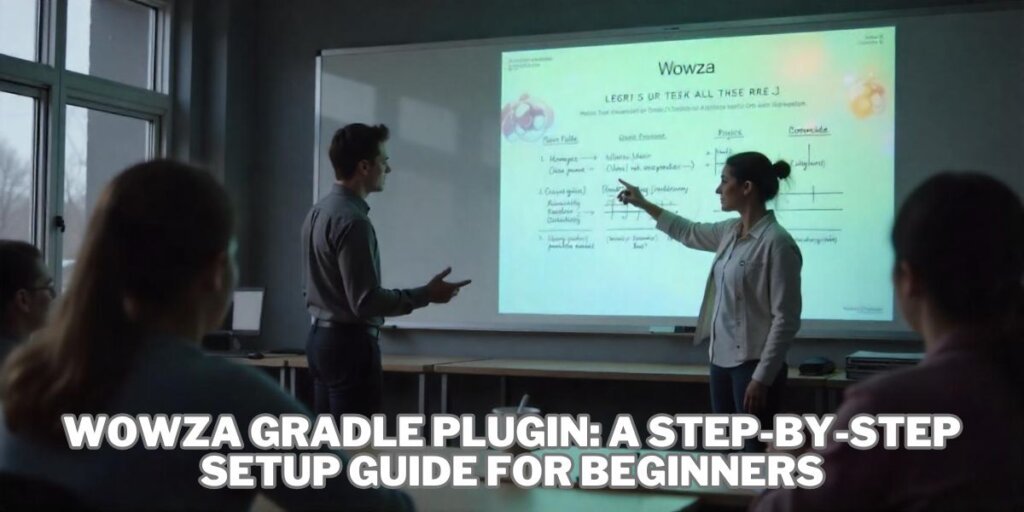
The Wowza Gradle Plugin helps connect Gradle with Wowza. It makes building and deploying streaming apps easier. This plugin saves time and reduces setup errors.
Are you new to Wowza development? Struggling with long setup steps? The Wowza Gradle Plugin makes things simple. It helps you build and deploy quickly. Let’s make streaming development easier together.
The Wowza Gradle Plugin speeds up project setup and deployment. It supports media streaming apps and automates key build tasks. You can add Wowza Streaming Engine integration easily. It improves your workflow with clean code. Using it helps save time and avoid mistakes.
What is the Wowza Gradle Plugin?
The Wowza Gradle Plugin is a powerful integration tool that simplifies the process of managing and deploying Wowza Streaming Engine configurations using Gradle. Gradle, an open-source automation tool used primarily for building, testing, and deploying software, can be combined with Wowza Streaming Engine to streamline the creation and management of live streaming workflows.
The Role of Gradle in Streaming Workflows
Gradle is highly flexible and can be adapted to various types of workflows, including media streaming. By using the Wowza Gradle Plugin, developers and media professionals can leverage Gradle’s automation capabilities to configure Wowza Streaming Engine setups, manage updates, and integrate them into larger CI/CD pipelines. This integration ensures that complex streaming setups are handled with ease and consistency, reducing the chances of errors during deployment.
Key Features of the Wowza Gradle Plugin
Before diving into installation and usage, it’s essential to understand the core features of it. Here are the key aspects that make this plugin indispensable for modern streaming setups:
Automated Configuration Management
The Wowza Gradle Plugin enables automated management of Wowza Streaming Engine configurations. Developers can define their streaming settings, server properties, and configurations within Gradle’s build files. This automation makes it easy to replicate and scale setups across multiple environments, ensuring consistency in deployment.
Seamless Integration with Gradle Build Systems
With it, users can easily integrate Wowza Streaming Engine configurations into their existing Gradle build systems. This ensures that everything from the encoding profiles to the server settings is built and deployed automatically, aligning with the team’s overall development and deployment workflows.
Support for Multiple Environments
The plugin supports multiple environments, such as development, staging, and production, allowing for easy configuration management across different setups. This feature is crucial for large-scale streaming operations where you might need different settings based on the environment.
Real-Time Streaming Monitoring and Reporting
It helps to manage the monitoring of your streaming servers in real time. It integrates with Wowza Streaming Engine’s internal monitoring tools, giving you insight into stream health, server performance, and overall streaming quality.
Advanced Error Handling and Troubleshooting
By automating and centralizing configuration management, the plugin also helps with debugging and error handling. With the plugin’s detailed error logs and reports, developers can quickly identify issues, making troubleshooting a much faster and more efficient process.
How to Install the Wowza Gradle Plugin
Installing it is straightforward, but you must ensure that you have a working Gradle environment set up. Here’s a step-by-step guide on how to install the plugin.
Prerequisites
Before starting the installation, make sure you have the following:
- Gradle is installed on your machine. You can check if Gradle is installed by running the following command in your terminal: bashCopyEdit
gradle -vIf Gradle is not installed, visit the Gradle installation guide for instructions. - Wowza Streaming Engine is up and running. You can download Wowza Streaming Engine from the Wowza website.
Step 1: Add the Plugin to Your Build File
To start using it, you need to add it to your build.gradle file. In your Gradle project’s build.gradleAdd the following code:
groovyCopyEditplugins {id 'com.wowza.wowza-gradle-plugin' version '1.0'}
This code adds it to your project. Ensure you’re using the latest version of the plugin for better compatibility and features.
Step 2: Configure Plugin Settings
After adding the plugin, configure the settings specific to your Wowza Streaming Engine setup. This includes specifying the server URL, credentials, and other configurations that are unique to your streaming environment. You can define these settings in the build.gradle file as follows:
groovyCopyEditwowza {serverUrl = 'http://your-wowza-server.com'adminUsername = 'admin'adminPassword = 'password'apiKey = 'your-api-key'}
Step 3: Synchronize and Test the Plugin
Once the plugin is installed and configured, sync your Gradle project by running the following command:
bashCopyEditgradle build
This will download the necessary dependencies and integrate it into your project. Test the configuration by running some basic Wowza commands to check if everything is functioning correctly.
How to Use the Wowza Gradle Plugin
Now that the plugin is installed, let’s look at how to use it for day-to-day tasks. It simplifies several aspects of working with Wowza Streaming Engine.
1. Deploy Streaming Applications of Wowza Gradle Plugin
One of the primary use cases for it is to automate the deployment of streaming applications. With a simple Gradle task, you can upload and configure applications on your Wowza server, saving you from manually configuring settings.
bashCopyEditgradle deployApplication
This task automatically uploads your streaming application and applies any necessary configurations specified in your build file.
2. Configure Server Settings of Wowza Gradle Plugin
The plugin allows you to manage server-level configurations like stream aliases, live streams, and more. By defining these settings within the build.gradle file, you can ensure that your server is configured correctly every time it’s deployed or updated.
bashCopyEditgradle configureServer
3. Stream Health and Performance Monitoring of Wowza Gradle Plugin
For advanced users, the plugin can be configured to report on stream health, server status, and live performance metrics. These reports help you stay ahead of potential issues with stream quality and server performance.
bashCopyEditgradle monitorStreamingHealth
4. Error Handling and Rollbacks of Wowza Gradle Plugin
In case something goes wrong during deployment, it allows you to roll back changes and troubleshoot issues efficiently. You can use Gradle to review logs and make necessary corrections to server configurations.
bashCopyEditgradle rollbackDeployment
Best Practices for Using the Wowza Gradle Plugin
To maximize the potential of the Wowza Gradle Plugin, consider implementing these best practices in your workflow.
1. Version Control Your Configuration Files
Always use version control for your Gradle configuration files. This allows for easy collaboration and ensures that everyone on your team is using the same configurations for deployments.
2. Automate Test Deployments
Implement automated test deployments in your CI/CD pipelines. This way, every change made to the Wowza configuration is tested before being pushed to production. This practice significantly reduces the risk of errors and stream outages.
3. Monitor Server Health Regularly
Use the monitoring features of the Wowza Gradle Plugin to keep an eye on server health and streaming performance. Proactive monitoring can help identify potential problems before they impact your viewers.
4. Stay Up-to-Date with Plugin Updates
The Wowza Gradle Plugin, like all software, gets periodic updates. Keep an eye out for updates to ensure that you benefit from the latest features, bug fixes, and performance improvements.
Why Use the Wowza Gradle Plugin?
Now that you understand the ins and outs of the Wowza Gradle Plugin, you might wonder, “Why should I use this tool?” Here are some reasons why it is essential for anyone working with Wowza Streaming Engine:
- Streamlined Workflows: By automating configuration management, deployment, and monitoring, the Wowza Gradle Plugin allows for smoother workflows and fewer manual interventions.
- Scalability: As your streaming setup grows, you can scale your operations by using automated Gradle tasks, making it easier to manage larger and more complex setups.
- Consistency: By defining all configurations in the
build.gradlefile, you ensure that all your environments, development, staging, and production, are in sync, reducing the chances of configuration drift. - Error Reduction: Automation helps to reduce human error. With the plugin handling configuration and deployment, the likelihood of misconfigurations and issues in live streams decreases significantly.
FAQs
What is the Wowza Gradle Plugin?
It connects Gradle to the Wowza Streaming Engine. This helps build and deploy streaming apps easily.
Is the Wowza Gradle Plugin beginner-friendly?
Yes, it’s made for quick setup and use. You don’t need advanced coding skills to start.
How do I install the Wowza Gradle Plugin?
You add it to your build.gradle file. Then sync your project, and it’s ready to use.
Can I use it for live streaming projects?
Yes, it works great for live and on-demand video. It supports Wowza media streaming features.
Does the plugin save time during deployment?
Yes, it automates tasks and cuts down manual steps. You can deploy faster with fewer errors.
Conclusion
The Wowza Gradle Plugin is an essential tool for developers and media professionals looking to automate and streamline their video streaming workflows. By integrating Wowza Streaming Engine with Gradle, this plugin enhances deployment, configuration, and monitoring tasks, making it easier to manage and scale streaming setups. With its robust feature set and ease of integration, it is a must-have for anyone serious about delivering high-quality live streams.
So, if you’re ready to unlock the full potential of your streaming workflows, it might be just the tool you need. Implementing this plugin will ensure that you can deliver exceptional video content while saving time, reducing errors, and enhancing scalability across your operations.



